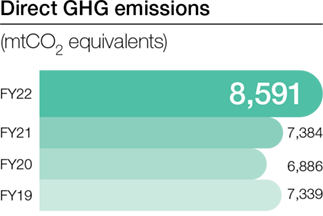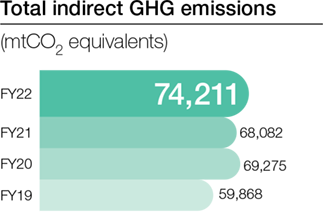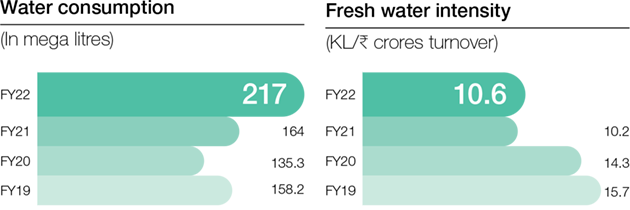Natural capital 
Environmental preservation
We have deployed systems and processes that are designed to promote responsible manufacturing practices, robust resource management and compliance with applicable rules and regulations. Our systematic approach towards reducing our carbon footprint and creating a positive impact on the environment includes improving energy efficiency, increasing the share of renewables in the energy mix while moderating our use of water and minimising waste generation.
We have implemented Quality, Energy, Environmental,Occupational Health and Safety (QEEHS) policy covering all operations. Our plants are ISO 14001 and ISO 50001* certified.
* Ghiloth Plant, commissed in 2019, is expected to be certified in ISO 50001 by end of Q2 FY2023
Climate change mitigation
We believe that climate change is a defining issue of our time and we must act responsibly to mitigate its impact. Various initiatives have been undertaken by us with regard to adopting clean technology, improving energy efficiency, and using renewable energy, etc. Some of the major initiatives include rainwater harvesting at our sites, sewage and effluent treatment plants for recycling wastewater, captive solar power plants with total capacity of 9.0 MW, etc.. Our focus has been on reducing our environmental footprint particularly around reducing emissions to combat climate change.
Green buildings
Our manufacturing facilities at Ghiloth and Alwar, Rajasthan, have been accorded the Indian Green Building Council (IGBC) Gold-rated certification, under IGBC Factory Building Rating system.
9%
Share of renewable energy in total electricity consumed in FY 2021-22
9.0 MW
Solar power generation capacity
6,700 tCO2e
Emissions mitigated with solar usage
53%
Reduction in specific energy intensity as compared to base year 2015-16
1,435 tCO2e
Reduction in GHG emissions through 41 electricity reduction initiatives
Reducing Greenhouse Gas (GHG) emissions
Direct (Scope 1) GHG emissions
Over the years, we have been working persistently towards reducing our carbon footprint and use of natural gas-based furnaces, among others.

Indirect (Scope 2) GHG emissions
We have implemented ISO:50001 energy management system and completed 41 energy saving initiatives, saving 1,435 tCO2e of emissions in FY 2021-22.

Other indirect (Scope 3) GHG emissions
Under Scope 3 emissions, we only considered employee commute for the reporting period. During FY 2021-22, due to COVID-induced lockdowns and work-from-home strategies, Scope 3 emissions were at an all-time low of 3,510.22 mtCO2e.
Efficient use of raw materials
We use a variety of raw materials, including different metals, plastics, resins and PVC, among others. We are engaged in the constant process of evaluating how we can reduce our consumption of these resources while looking at alternatives.
Virgin raw materials used in FY 2021-22
| Parameter | Units |
|---|---|
| Raw materials | 1,23,567 MT |
| Associated process material (Warnish, paint, powder) | 36,414 MT |
| Associated process material (Paint, thinner) | 11,27,730 Litres |
| Semi-manufactured goods or parts | 5, 52,842 No.s |
| Packaging material (Wooden items) | 10,69,425FT3 |
| Packaging material (Product packaging, label, thermocole, box, etc.) | 56,06,68,018 No.s |
| Packaging material (Adhesive tape, wax resin, PP strap, etc.) | 2,28, 94,506 Metres |
| Packaging material (Polybags, laminates, steel cable drum, bolts, etc.) | 4278 MT |
| Energy intensity GJ per rupee of turnover | 40.1 |
Circular economy
We are progressively including material circularity in our product design and processes while ensuring high quality and durability. We also undertake rigorous testing of our products and provide post-sales services to increase their shelf life, thereby reducing requirements for natural resources.
Waste management
We have implemented waste segregation at source. We have a stringent waste management system for hazardous and non-hazardous waste generated at Havells. We are strengthening our environmental protection policies by focusing on specific issues such as effective storage, handling, transportation and disposal of hazardous waste generated at our units. Currently, all such waste is disposed of only through dealers authorised by Central/State Pollution Control Boards. During the year, we recycled 7,585 MT of nonhazardous waste and reused 641.3 MT, including metal, rubber and plastic scrap.
During the year, there were no significant spills to be reported and we disposed of 308 MT of hazardous waste.
Zero
Non-hazardous waste to landfill during FY 2021-22
<2.67%
Total hazardous waste was sent to landfill during FY 2021-22
Plastic Waste Management (PWM)
We take the responsibility of disposing plastic wastes associated with our product packaging. To fulfil our Extended Producer Responsibility (EPR), we are collecting plastic low density polyethylene (LDPE) bags and thermocol. Till date , we have reclaimed approximately 3000MT of plastic waste from the eco-system. For the forthcoming year , we will be reclaiming ~3500MT of plastic waste.
Reduction of plastic use in packaging
Removal of metallised PET film from our packaging
Exploring the feasibility of replacing EPS from our packaging with corrugated or honeycomb fillers
Exploring the feasibility of bio-degradable plastic bags for our packaging
Using pulp-molded trays for our water heater packaging to replace thermocol
Exploring the feasibility of paper-based tapes to replace BOPP tapes in lighter weight packaging
Using recycling bins instead of plastic packaging for some of our raw materials to be used in production
Emission management
Ozone-depleting substances (ODS)
In line with the Montreal Protocol and other international standards, we are consciously moving away from the use of ODS in our refrigerants for air conditioners and refrigerators. As a result, we launched the environmentfriendly Lloyd refrigerators with zero ODS last year. Further, conscious of emissions from air conditioning at our office buildings, we have reduced our consumption of ozone-depleting R-22 refrigerant by more than 60% as compared to FY 2019 and plan to go zero R-22 in the near future.

NOx and SOx emissions
At Havells, our operations release minuscule amounts of nitrogen oxides (NOx) and sulphur oxides (SOx) and we consistently work to minimise these emissions. We regularly monitor our process emissions from our oven and Diesel Genset (DG) stacks and maintain emissions under permissible limits, with the help of air pollution control equipment.

Water stewardship
We believe that water usage sensitisation along with infrastructure that supports responsible water use is key to water conservation. We have set up, across plants, dry powder-based paint shops instead of the conventional water-based paint shops; and flow regulated taps, arresting water leakages and closed unnecessary water distribution points. Pilot studies have been taken up to increase the use of recycled water for domestic use. We have deployed automatic water recirculation system in our factory kitchens for utensil cleaning in select plants to gauge water savings.
All our factories are equipped with Sewage Treatment Plant (STP) and four of them are equipped with Effluent Treatment Plant (ETP) as well. Almost all of the treated water is reused within our premises to flush toilets or in developing greenbelt and plantation.
The plumbing infrastructure required to reuse STP treated water is being implemented. Our Faridabad unit was the only one which discharged treated water (after maintaining the minimum discharge standards) into municipal sewage line with consent from the authorities concerned during the reporting period. We follow all the necessary applicable guidelines and directions on maintaining the standards of STP and ETP required by CPCB and SPCBs. Rainwater harvesting structures are installed at all our facilities and the water harvested is used for ground recharge.

Water recycling
| Parameter | Mega litres |
|---|---|
| STPs | 58.5 |
| ETPs | 18.1 |
| Total | 76.6 |